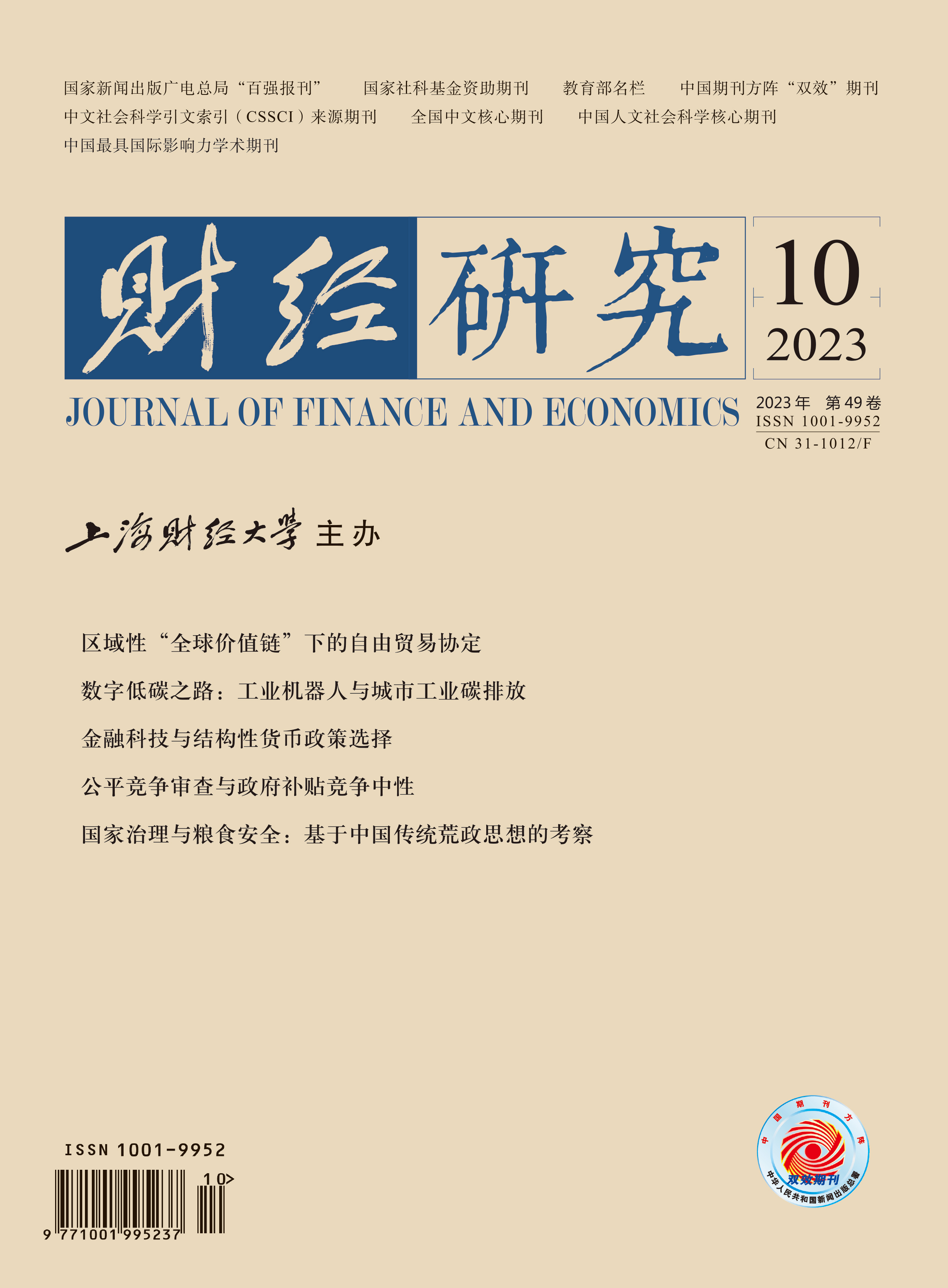随着人工智能技术与经济社会的深度融合发展,工业机器人已经成为推动经济低碳转型发展的重要驱动力。已有研究主要从劳动力市场视角讨论了工业机器人的经济效应,而文章主要考察了工业机器人对城市工业碳排放的影响。首先,文章构建包含工业机器人和能源投入的理论模型。理论研究表明,工业机器人能够赋能城市工业碳减排。其次,利用中国城市面板数据的实证研究发现工业机器人有效降低城市工业碳排放,推动城市经济向低碳方向发展,且具有长期影响。异质性分析发现,工业机器人能够抑制非资源型城市、数字化水平较高城市、东部以及南方城市的工业碳排放,但对资源型城市、数字化水平较低城市、中西部以及北方城市的影响不显著。机制检验结果表明,在工业机器人发挥城市工业碳减排效应的过程中,绿色技术创新和人机匹配度是重要的作用机制。进一步采用门槛模型发现,随着互联网普及率、人力资本水平和政府科技投入的提升,工业机器人减排效应呈边际效应递增态势,这意味着完善宽带基础设施建设、提高人力资本水平、加大财政科技投入是促进工业机器人减排效应的实现路径。文章的研究为利用人工智能技术实现“双碳”目标,促进经济低碳转型提供了经验证据和政策启示。
数字低碳之路:工业机器人与城市工业碳排放
摘要
参考文献
26 Acemoglu D, Restrepo P. Modeling automation[J]. AEA Papers and Proceedings,2018,108: 48−53. DOI:10.1257/pandp.20181020
27 Acemoglu D, Restrepo P. Automation and new tasks: How technology displaces and reinstates labor[J]. Journal of Economic Perspectives,2019,33(2): 3−30. DOI:10.1257/jep.33.2.3
28 Acemoglu D, Restrepo P. Robots and jobs: Evidence from US labor markets[J]. Journal of Political Economy,2020,128(6): 2188−2244. DOI:10.1086/705716
29 Autor D H, Levy F, Murnane R J. The skill content of recent technological change: An empirical exploration[J]. The Quarterly Journal of Economics,2003,118(4): 1279−1333. DOI:10.1162/003355303322552801
30 Chen X H, Gong X M, Li D Y, et al. Can information and communication technology reduce CO2 emission? A quantile regression analysis[J]. Environmental Science and Pollution Research,2019,26(32): 32977−32992. DOI:10.1007/s11356-019-06380-8
31 Ghobakhloo M, Fathi M. Industry 4.0 and opportunities for energy sustainability[J]. Journal of Cleaner Production,2021,295: 126427. DOI:10.1016/j.jclepro.2021.126427
32 Graetz G, Michaels G. Robots at work[J]. The Review of Economics and Statistics,2018,100(5): 753−768. DOI:10.1162/rest_a_00754
33 Kromann L, Malchow-Møller N, Skaksen J R, et al. Automation and productivity—a cross-country, cross-industry comparison[J]. Industrial and Corporate Change,2020,29(2): 265−287.
34 Lange S, Pohl J, Santarius T. Digitalization and energy consumption. Does ICT reduce energy demand?[J]. Ecological Economics,2020,176: 106760. DOI:10.1016/j.ecolecon.2020.106760
35 Lee K H, Min B. Green R&D for eco-innovation and its impact on carbon emissions and firm performance[J]. Journal of Cleaner Production,2015,108: 534−542. DOI:10.1016/j.jclepro.2015.05.114
37 Li M J, Tao W Q. Review of methodologies and polices for evaluation of energy efficiency in high energy-consuming industry[J]. Applied Energy,2017,187: 203−215. DOI:10.1016/j.apenergy.2016.11.039
38 Li Y Y, Zhang Y R, Pan A, et al. Carbon emission reduction effects of industrial robot applications: Heterogeneity characteristics and influencing mechanisms[J]. Technology in Society,2022,70: 102034. DOI:10.1016/j.techsoc.2022.102034
40 Shan Y L, Guan D B, Zheng H R, et al. China CO2 emission accounts 1997-2015[J]. Scientific Data,2018,5(1): 170201. DOI:10.1038/sdata.2017.201
41 Sun H Y, Kim G. The composite impact of ICT industry on lowering carbon intensity: From the perspective of regional heterogeneity[J]. Technology in Society,2021,66: 101661. DOI:10.1016/j.techsoc.2021.101661
42 Vinuesa R, Azizpour H, Leite I, et al. The role of artificial intelligence in achieving the Sustainable Development Goals[J]. Nature Communications,2020,11(1): 233. DOI:10.1038/s41467-019-14108-y
43 Wang E Z, Lee C C, Li Y Y. Assessing the impact of industrial robots on manufacturing energy intensity in 38 countries[J]. Energy Economics,2022,105: 105748. DOI:10.1016/j.eneco.2021.105748
44 Xu T T, Kang C Y, Zhang H. China's efforts towards carbon neutrality: Does energy-saving and emission-reduction policy mitigate carbon emissions?[J]. Journal of Environmental Management,2022,316: 115286. DOI:10.1016/j.jenvman.2022.115286
45 Zhou X Y, Zhou D Q, Wang Q W, et al. How information and communication technology drives carbon emissions: A sector-level analysis for China[J]. Energy Economics,2019,81: 380−392. DOI:10.1016/j.eneco.2019.04.014
引用本文
黄赜琳, 蒋鹏程. 数字低碳之路:工业机器人与城市工业碳排放[J]. 财经研究, 2023, 49(10): 34-48.
导出参考文献,格式为:





 4360
4360  6055
6055

